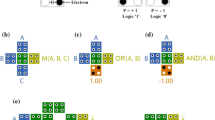Abstract
A radiation hardened by design (RHBD) latch and its temporally hardened version to tolerate double node upsets are proposed in this paper. C-Elements are used to construct structures for fault correction. The temporally hardened version can further tolerate some single-event transients (SETs) at input port and clock line. Compared with Quintuple Modular Redundancy (QMR), the proposed non-temporally and temporally hardened latches are more area and power efficient with improved propagation delays. Compared with several previously reported temporally hardened latches, the proposed temporally hardened latch may introduce lower performance loss induced as setup time increase. Several multi-node upset tolerant latches are also compared with these two designs in terms of area, power, and delay. A cell level soft error analysis (TFIT) shows that the upset threshold LETs of the proposed latches in 180 nm process are higher than 16 MeV-cm2/mg.













Similar content being viewed by others
References
Amusan OA, Witulski AF, Massengill LW, Bhuva BL, Fleming PR, Alles ML, Sternberg AL, Black JD, Schrimpf RD (2006) Charge collection and charge sharing in a 130 nm CMOS technology. IEEE Trans Nucl Sci 53(6):3253–3258
Balasubramanian A, Bhuva BL, Black JD, Massengill LW (2005) RHBD techniques for mitigating effects of single-event hits using guard-gate. IEEE Trans Nucl Sci 52(6):2531–2535
Baumann RC (2001) Soft errors in advanced semiconductor devices—part I: the three radiation sources. IEEE Trans Device Mater Rel 1(1):17–22
D’Alessio M, Ottavi M, Lombardi F (2014) Design of a nanometric CMOS memory cell for hardening to a single event with a multiple-node upset. IEEE Trans Device Mater Rel 14(1):127–132
Gadlage MJ, Eaton PH, Benedetto JM, Turflinger TL (2005) Comparison of heavy ion and proton induced combinatorial and sequential logic error rates in a deep submicron process. IEEE Trans Nucl Sci 52(6):2120–2124
Gadlage MJ, Ahlbin JR, Narasimham B, Bhuva BL, Massengill LW, Reed RA, Schrimpf RD, Vizkelethy G (2010) Scaling trends in SET pulse widths in sub-100 nm bulk CMOS processes. IEEE Trans Nucl Sci 57(6):3336–3341
Heidel DF, Marshall PW, Pellish JA, Rodbell KP, LaBel KA, Schwank JR, Rauch SE, Hakey MC, Berg MD, Castaneda CM, Dodd PE, Friendlich MR, Phan AD, Seidleck CM, Shaneyfelt MR, Xapsos MA (2009) Single-event upsets and multiple-bit upsets on a 45 nm SOI SRAM. IEEE Trans Nucl Sci 56(6):3499–3504
iROC Technologies (2014) TFIT reference manual, software version:4.0
Katsarou K, Tsiatouhas Y (2014) Double node charge sharing SEU tolerant latch design. In: Proceedings of the IEEE International On-Line Testing Symposium (IOLTS): 122–127
Katsarou K, Tsiatouhas Y (2015) Soft error interception latch: double node charge sharing SEU tolerant design. Electron Lett 51(4):330–332
Knudsen JE, Clark LT (2006) An area and power efficient radiation hardened by design flip-flop. IEEE Trans Nucl Sci 53(6):3392–3399
Lacoe RC (2009) Improving integrated circuit performance through the application of hardness-by-design methodology. IEEE Trans Nucl Sci 55(4):1903–1925
Lin S, Kim Y-B, Lombardi F (2012) Analysis and design of nanoscale CMOS storage elements for single-event hardening with multiple-node upset. IEEE Trans Device Mater Rel 12(1):68–77
Mahatme NN, Jagannathan S, Loveless TD, Massengill LW, Bhuva BL, Wen S-J, Wong R (2011) Comparison of combinational and sequential error rates for a deep submicron process. IEEE Trans Nucl Sci 58(6):2719–2725
Maru A, Shindou H, Ebihara T, Makihara A, Hirao T, Kuboyama S (2010) DICE-based flip-flop with SET pulse discriminator on a 90 nm bulk CMOS process. IEEE Trans Nucl Sci 57(6):3602–3608
Massengill LW, Tuinenga PW (2008) Single-event transient pulse propagation in digital CMOS. IEEE Trans Nucl Sci 55(6):2861–2871
Matush BI, Mozdzen TJ, Clark LT, Knudsen JE (2010) Area-efficient temporally hardened by design flip-flop circuits. IEEE Trans Nucl Sci 57(6):3588–3595
Namba K, Sakata M, Ito H (2010) Single event induced double node upset tolerant latch. In: Proceedings of the 2010 International Symposium on Defect and Fault Tolerance in VLSI Systems: 280–288
Noh J, Correas V, Lee S, Jeon J, Nofal I, Cerba J, Belhaddad H, Alexandrescu D, Lee YK, Kwon S (2015) Study of neutron soft error rate (SER) sensitivity: investigation of upset mechanisms by comparative simulation of FinFET and planar MOSFET SRAMs. IEEE Trans Nucl Sci 62(4):1642–1649
She X-X, Li N, Farwell WD (2010) Tunable SEU-tolerant latch. IEEE Trans Nucl Sci 57(6):3787–3794
She X-X, Li N, Tong J (2012) SEU tolerant latch based on error detection. IEEE Trans Nucl Sci 59(1):211–214
Shuler RL, Balasubramanian A, Narasimham B, Bhuva BL, O’Neill PM, Kouba C (2006) The effectiveness of TAG or C-elements in SET suppression using delay and dual-rail configurations at 0.35 μm. IEEE Trans Nucl Sci 53(6):3428–3431
Weste NHE, Harris DM (2011) CMOS VLSI design-A circuits and systems perspective, 4th edn. Addison-Wesley, Boston, pp 391–395
Wirth G, Kastensmidt FL, Ribeiro I (2008) Single event transients in logic circuits—load and propagation induced pulse broadening. IEEE Trans Nucl Sci 55(6):2928–2935
Zhou Q-M, Mohanram K (2006) Gate sizing to radiation harden combinational logic. IEEE Trans Comput-Aided Design Integr Circuits Syst 25(1):155–166
Acknowledgments
The authors appreciate the supports from CMC Microsystems, iROC Technologies, and NSFC under contract No. 61504038.
Author information
Authors and Affiliations
Corresponding author
Additional information
Responsible Editor: S. Hellebrand
Rights and permissions
About this article
Cite this article
Li, Y., Wang, H., Yao, S. et al. Double Node Upsets Hardened Latch Circuits. J Electron Test 31, 537–548 (2015). https://doi.org/10.1007/s10836-015-5551-3
Received:
Accepted:
Published:
Issue Date:
DOI: https://doi.org/10.1007/s10836-015-5551-3




